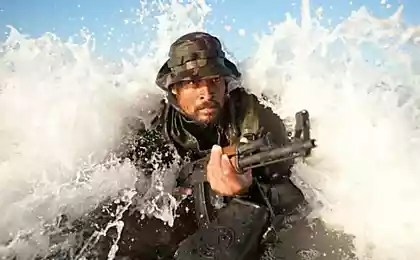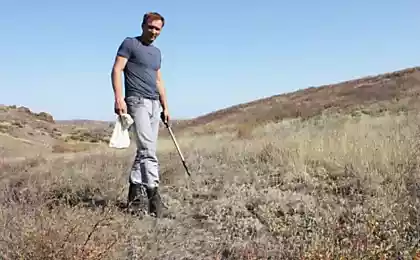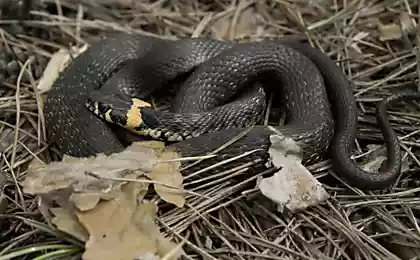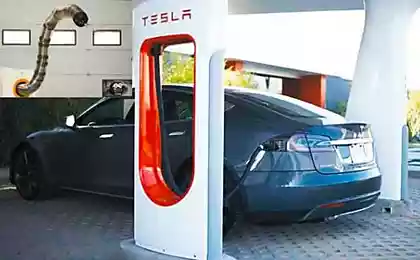1620
Sea snakes
Cavivermis dzonoti - almost blind sea serpent living in giant cave systems of the Yucatan.
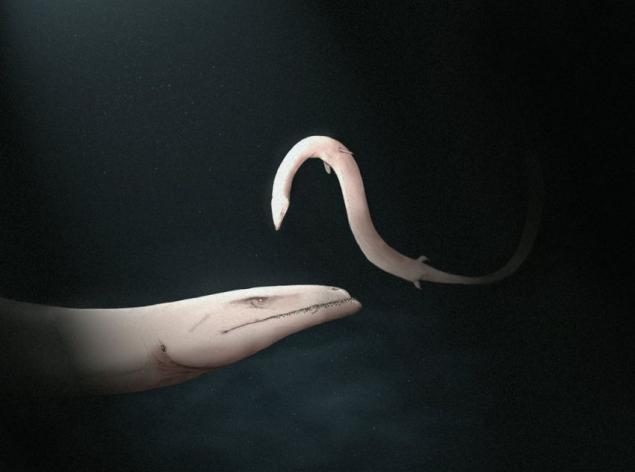
Altonatator, inhabitant of the Antarctic waters - a very social animal. They live in small groups of 4 to 9 individuals, and often hunt together. Cubs learn from adults and do not leave the group before the age of 6 years.

The first four groups of the left - aquatic animals, including the famous mosasaurs, were so perfect "seafarer", which appeared in the mid-Cretaceous, were able to win a place under the sun in such sea monsters as pliosaurs and ichthyosaurs. Well, as you can see, the similarities natriksozavrov (natrixosaurs, from Lat. Natrix - «sea serpent") with mosasaurs not accidental, they are pretty close relatives. Although different in many ways (though not as much as lizards by dragons): snakes can dive deeper, have a different structure of the caudal fin, are differently situated nostrils, a long neck (and even more serpentine constitution) and relatively large brains .
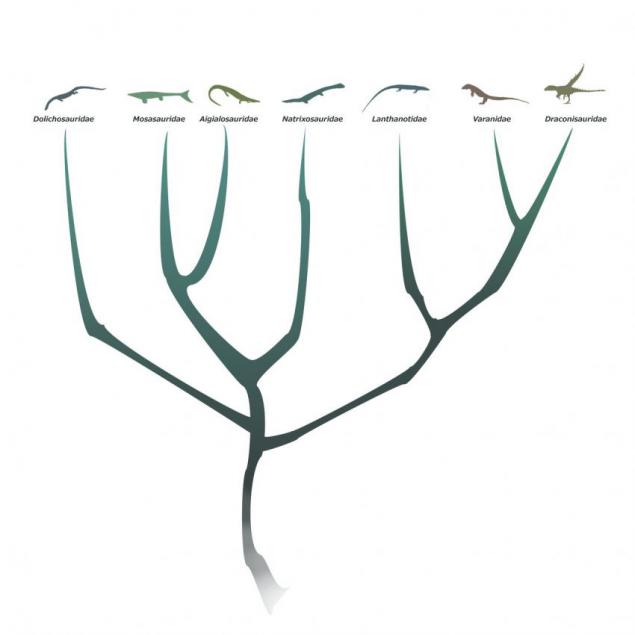
It is noteworthy that during the mosasaurs ancestors sea serpents were ground lizards, and to aquatic life passed only after the Cretaceous-Paleogene extinction event, so treat them as "living fossils" or direct descendants of mosasaurs, they believed in the past, some scientists are wrong - it is quite "modern" animal creations Cenozoic.

This is one of the oldest natriksozavrid inhabiting the end of the Paleocene in the area of present-day Argentina. Unlike other fossil genera of sea serpents, avroranatator known for more than one sample - Paleontologists have discovered the remains of an entire group of these creatures, which received an unofficial nickname "The 12 Apostles" and are now kept at the Institute of Biology in Buenos Aires (catalog number: IBSF BA 3B 183). With an abundance of material, was able to restore almost complete skeleton (missing fragments are shown in red). The largest observed specimen did not exceed a length of 183, 7 cm. The limbs of these creatures were still able to move their owners on the land, but a number of features indicates that avroravenator have linked their lives to the sea - it traces of salt glands in front of the eye sockets, the location of the nostrils and increased as compared to the ground varanoidami number of cervical vertebrae. The teeth were very similar to the teeth of conventional monitor lizards, and accurately determine their diet is quite difficult, but most likely in their diet included fish and small animals coastal shallows.

Fokavaran - later natriksozavrid fossil representative of the Upper Eocene of India. It is known as a part of the spine, feet, several ribs and the rear of the skull. It looks like he was still a semi-aquatic animals with limbs, suitable for movement on land.
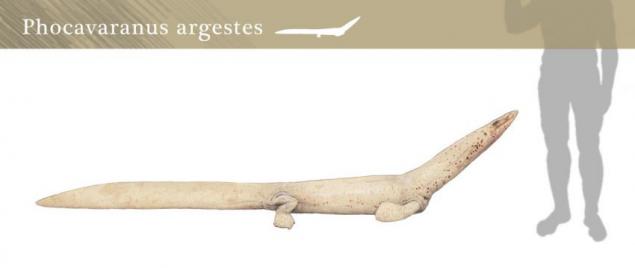
The oldest fully aquatic natriksozavrid, which can rightfully be called a sea serpent, found in Egypt in the Oligocene strata of Wadi Al-Hitan. One of the first detected fragments shown in the picture: a piece of jaw. Following the discovery of other skeletal fragments it became clear that they belong to one of the most specialized of the known natriksozavrid. His jaw were flat, often with spaced teeth. In addition, the length of it was 1, 8 m - it is very small for an adult sea serpent. Today, most scientists believe that anatonatriks preyed mainly on small schooling fish and shrimp from the fall-like filter device and could initiate the evolutionary line of sea serpents filter feeders. However, the whales have been more successful in this field.

Three little today, but by now extinct species of freshwater sea serpents, also called river dragons. These small natriksozavridy of Eurasia (and perhaps North Africa) inhabited our rivers and lakes soon after the last ice age. Genetic analysis of well-preserved specimens showed that this subfamily of many ancient glaciers. These animals have evolved 2 million years ago on the Indian Ocean coast and stayed in a warm climate for most of the ice age, spreading to more temperate latitudes during periods of interglacial periods. In the Middle Ages and oktsidanatatory yantszynatatory extinct due to human influence. Mekongnatator stay a little longer, but at the end of the XVIII century and it disappeared from the rivers of Southeast Asia. These sea serpents are a universal predators; sharp teeth at the front of the jaws are ideal for fishing, while two rows of flat palatine teeth used for crushing the shells of crustaceans and mollusk shells.
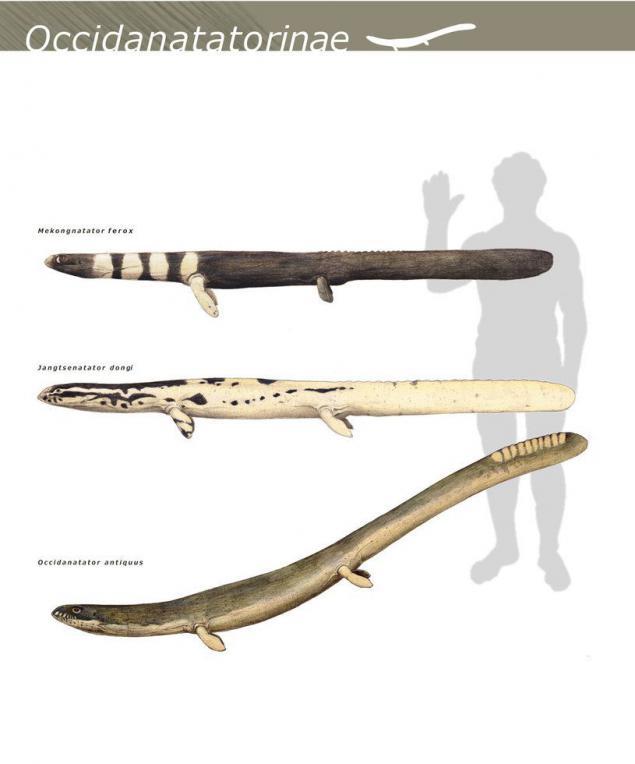
Cavinatrix (aka Cavivermis (the old name), shown in the title picture) is the last living representative of false river snakes and freshwater sea snakes of the New World. In addition, it is unique in that it is troglobionts. These creatures live in huge cave systems, the outputs of which are known as cenotes. In the darkness of the caves are in search of a partner and production do not rely on sight, and smell and electroreceptors located at the tip of the snout. Their diet consists mainly of fish and crustaceans, reptiles and small mammals that come to drink the cenote, and waterfowl. During the mating season (September) females secrete pheromones that attract males, between which in this period are frequent fierce battle for the right to mate. After three months, females give birth to one or two, from 28 to 32cm in length, young, leaving his mother a few hours. You may have noticed the claws on the hind legs of this species. The males use them to cling to the females during mating - not so much in order not to lose a girlfriend in the dark as to prevent male-rivals split the loving couple.
And yes, an important detail - a live birth is common to all modern sea snakes. This is not a unique phenomenon among all marine reptiles - known findings ichthyosaurs with embryos in the belly - and among members of the order of scaly in particular, including some quite modern terrestrial lizards and snakes, not to mention the mosasaurs.

Another recently extinct, representative of the freshwater sea serpents, a former resident of the Amazon and Orinoco. The last representative of the type seen in 1943. Some cryptozoologists believe that Proserpine moglasohranitsya in remote areas of South America, but eyewitness accounts, which they refer to the evidence seems to describe a meeting with big caimans. The morphology of this species is mainly known thanks to several subfossil finds and old images of early explorers (one of the first who described this species in detail, was Alexander von Humboldt during his travels to the Orinoco). On the behavior of known almost nothing, but it can be assumed that Proserpine was predominantly fish-eating predator that, given the diversity of fish fauna of the Amazon, it is not surprising. Among the Indians of the Amazon is being known as yakumama.
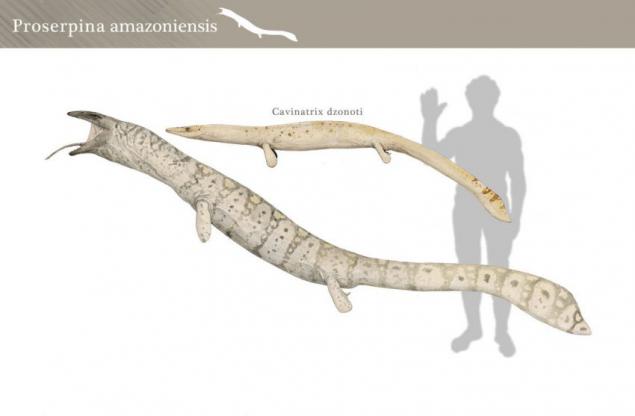
Bibonatrix (literally "drinking the sea snakes") - a rather strange name for such a wonderful creature, slender and elegant movements; these sea snakes, certainly one of the most beautiful animals in the Indian Ocean. Their names do not because they are the heroes of tales of drunken sea, and for the method of supply:

His jaw, neck and ribs special sublingual apparatus used to produce in the mouth area of low pressure, which sucks small prey when the snakes dramatically opens his mouth. The menu - crab, lobster, clams, groundfish, and many other animals living on the seabed. Bibonatriks usually stands motionless on the bottom with her head down, only occasionally correcting its position with the help of fins until it finds a production worthy of "suction". As kavinatriks, this species has electroreceptors on the tip of the snout to detect burrowed production. But bibonatriks also open water predator, capable of amazing speed over short distances. Usually, they prefer shallow, warm water and can be found in areas of coral reefs and - during the breeding season - in the mangroves where the female brings to the world of up to 4 small sea zmeenyshey. Natural enemies of them - Crocodiles (especially saltwater crocodile), sharks and sometimes killer whales, but they are usually ignored by predators. Today, the main threat to them - intensive pollution of the Indian Ocean: many states along its shores have no legal regulation for the disposal of waste at sea.

The most common sea serpent Pacific is also the fastest of natriksozavrid. These brightly colored animal swims in tropical regions of the Galapagos Islands to the Japanese archipelago. The long snout and sharp teeth Thin give his diet: fish and squid. Gratsilinatriks is a predator of the high seas, fast enough to hunt for the most fish, but unlike other pelagic sea serpents, he could hunt in the dark, chasing shoals of squid, rising to the surface at night. Another interesting point is the schooling behavior: some individuals can work together to bring down a school of fish into a tight ball, from which it is convenient to pick out the individual fishes. During April, the females come together on uninhabited islands in the middle of the Pacific Ocean. They find their way, guided by the Earth's magnetic field. Females give birth to two or three small marine zmeenyshey who left his mother a few days later. As pups, they often crawl on land for sunbathing, however, in adulthood, too, sometimes lie on the beaches deserted islands - not only warming, but also in search of prey on the coastline, such as coconut crabs.

Recorded and asperognata adult life, sometimes also called "dragon sperm," quite a bit. These animals live in the northern part of the Pacific Ocean, are very good divers can dive to depths of up to 1000 m. They survive at such depths due to the massive bones, relatively little light that is compressed during the dive and a high content of myoglobin in the tissues, and may conduct under water to 110 minutes. Asperognat preys mainly on squid, crabs and shellfish, may consume the carcasses of whales (as far as can be judged by the content of stomachs caught specimens). Part of the population of these kites migrate during the summer in the southern hemisphere (some authors suggest that this is a separate subspecies, while others believe that only eco-friendly type) By the end of the summer the females swim to his birthplace - the coasts of New Zealand and Chile, where each of them It gives life to a pair of generally 70 cm cubs. His mother soon after birth is sent back to the open ocean, but the young remain near the coast until they are able to dive after their parents in the dark abyss of the Pacific Ocean. This young and reflected in the mythology of the Maori under the myth of taniua. In historical times asperognat was very common sea serpent, but intensive hunting around New Zealand and species diversity of marine life today threaten the well-being of the form.
By the way, small pink bubble before the eyes of the figure is a gland, which serves to remove excess salt from the body - an important aromorphosis allowing sea snakes live permanently in seawater.

Classic sea serpent - a large, well-built, with a red neck and not as shy as most other natriksozavrid. Earlier this genus has been widely circulated on both sides of the Atlantic in the open ocean and in the Mediterranean, and now N. atlanticus avoid coastal waters, and N. priscus, Mediterranean species, became extinct with the advent of sophisticated techniques of whaling in the XVIII century. Here are two kinds:

Green on the map marked by the historic area of distribution of the genus, orange - today. Not surprisingly, that was the first natriksozavr sea serpent, has received a scientific description. Many samples have found their place in private collections, among nihznamenity from Copenhagen that gave the name of the genus and the entire family. With a length of over 6 meters (the largest known specimen was 7, 3 meters long and weighed 1040 kg 8) is one of the largest sea serpents. Another interesting fact is that our very modern word "dragon" is derived from that animal, which the ancient Greeks called δράκων (drákōn - «sea serpent"). In myths (such as Perseus and Andromeda) reflected the actual behavior of these animals: natriksozavr able to crawl on land for a short time and, like killer whales, and occasionally hunt in the surf, catching prey almost from the shore. No reliable evidence about the attack natriksozavra people there, but the ancient Greeks, no doubt, must have been impressed by this behavior. Normally this species is exclusively fish-eating, but sometimes small dolphins and young seals complete its way into his mouth, so that attacks on people are possible in principle, but the stories of sea serpents, topivshih whole ships - mostly fantasy. Only Halidraco, are known to attack small boats that protect the young:

A huge, terrible tales of sea serpents devouring small children and drowning ships for fun ... so you could say about halidrako if he was not just a big animal. More precisely, the largest reptile of living - up to 11 meters in length (the average individual is about 9 meters) - the largest and natriksozavridom, dozhivshim to the present day. These rather cautious giants live in the North Pacific and the Atlantic Ocean, where they occupy the top of the food chain. There are two types: H. sarcharodon plowing the Atlantic, and H. razificus - soobvetstvenno, from the Pacific Ocean. Halidrako known annual migration after the gray, humpback whales and killer whales through the Arctic Circle, especially H. razificus who studied in detail by several authors. Snakes follow large mammals because they are not only predators but scavengers. Killer whales often come together at the entrance to the Bering Sea, where they hunt mainly at young gray whales and humpbacks sometimes, while in an abundance of prey often eat only a small portion of the carcass, leaving enough for polar bears and sea serpents.
H. sarcharodon on migration is less well known, because there is no similarity in the Atlantic, the Aleutian Islands, with whom it was easy to watch out for snakes. It is known that some animals migrate along the coast of Norway (Jormungand you know?), Sometimes a few individuals seen off the coast of Canada (they may have inspired the myth of cadborosaurus willsi, but the inspiration and elk, seals, whales and floating trees). Due to the decrease of whale stocks fish is becoming more and more important source of food for sea serpents, and pregnant females often follow schools of herring, hunting is not only fish, but also some fish hunters. In the summer they plyvayutsya to fields of kelp, which usually give birth to two cubs. At the same time they molt occurs. Their skin is much thicker and richer in protein than other species, and young sea snakes gnaw it to the sides of their mothers - it is their first meal. After a few days or weeks, they begin to hunt themselves and mothers vozvraschyutsya into the ocean.

Finally - card 1943, which depicts halidrako, jumping out of the water:

Source: haritonoff.livejournal.com

Altonatator, inhabitant of the Antarctic waters - a very social animal. They live in small groups of 4 to 9 individuals, and often hunt together. Cubs learn from adults and do not leave the group before the age of 6 years.

The first four groups of the left - aquatic animals, including the famous mosasaurs, were so perfect "seafarer", which appeared in the mid-Cretaceous, were able to win a place under the sun in such sea monsters as pliosaurs and ichthyosaurs. Well, as you can see, the similarities natriksozavrov (natrixosaurs, from Lat. Natrix - «sea serpent") with mosasaurs not accidental, they are pretty close relatives. Although different in many ways (though not as much as lizards by dragons): snakes can dive deeper, have a different structure of the caudal fin, are differently situated nostrils, a long neck (and even more serpentine constitution) and relatively large brains .

It is noteworthy that during the mosasaurs ancestors sea serpents were ground lizards, and to aquatic life passed only after the Cretaceous-Paleogene extinction event, so treat them as "living fossils" or direct descendants of mosasaurs, they believed in the past, some scientists are wrong - it is quite "modern" animal creations Cenozoic.

This is one of the oldest natriksozavrid inhabiting the end of the Paleocene in the area of present-day Argentina. Unlike other fossil genera of sea serpents, avroranatator known for more than one sample - Paleontologists have discovered the remains of an entire group of these creatures, which received an unofficial nickname "The 12 Apostles" and are now kept at the Institute of Biology in Buenos Aires (catalog number: IBSF BA 3B 183). With an abundance of material, was able to restore almost complete skeleton (missing fragments are shown in red). The largest observed specimen did not exceed a length of 183, 7 cm. The limbs of these creatures were still able to move their owners on the land, but a number of features indicates that avroravenator have linked their lives to the sea - it traces of salt glands in front of the eye sockets, the location of the nostrils and increased as compared to the ground varanoidami number of cervical vertebrae. The teeth were very similar to the teeth of conventional monitor lizards, and accurately determine their diet is quite difficult, but most likely in their diet included fish and small animals coastal shallows.

Fokavaran - later natriksozavrid fossil representative of the Upper Eocene of India. It is known as a part of the spine, feet, several ribs and the rear of the skull. It looks like he was still a semi-aquatic animals with limbs, suitable for movement on land.

The oldest fully aquatic natriksozavrid, which can rightfully be called a sea serpent, found in Egypt in the Oligocene strata of Wadi Al-Hitan. One of the first detected fragments shown in the picture: a piece of jaw. Following the discovery of other skeletal fragments it became clear that they belong to one of the most specialized of the known natriksozavrid. His jaw were flat, often with spaced teeth. In addition, the length of it was 1, 8 m - it is very small for an adult sea serpent. Today, most scientists believe that anatonatriks preyed mainly on small schooling fish and shrimp from the fall-like filter device and could initiate the evolutionary line of sea serpents filter feeders. However, the whales have been more successful in this field.

Three little today, but by now extinct species of freshwater sea serpents, also called river dragons. These small natriksozavridy of Eurasia (and perhaps North Africa) inhabited our rivers and lakes soon after the last ice age. Genetic analysis of well-preserved specimens showed that this subfamily of many ancient glaciers. These animals have evolved 2 million years ago on the Indian Ocean coast and stayed in a warm climate for most of the ice age, spreading to more temperate latitudes during periods of interglacial periods. In the Middle Ages and oktsidanatatory yantszynatatory extinct due to human influence. Mekongnatator stay a little longer, but at the end of the XVIII century and it disappeared from the rivers of Southeast Asia. These sea serpents are a universal predators; sharp teeth at the front of the jaws are ideal for fishing, while two rows of flat palatine teeth used for crushing the shells of crustaceans and mollusk shells.

Cavinatrix (aka Cavivermis (the old name), shown in the title picture) is the last living representative of false river snakes and freshwater sea snakes of the New World. In addition, it is unique in that it is troglobionts. These creatures live in huge cave systems, the outputs of which are known as cenotes. In the darkness of the caves are in search of a partner and production do not rely on sight, and smell and electroreceptors located at the tip of the snout. Their diet consists mainly of fish and crustaceans, reptiles and small mammals that come to drink the cenote, and waterfowl. During the mating season (September) females secrete pheromones that attract males, between which in this period are frequent fierce battle for the right to mate. After three months, females give birth to one or two, from 28 to 32cm in length, young, leaving his mother a few hours. You may have noticed the claws on the hind legs of this species. The males use them to cling to the females during mating - not so much in order not to lose a girlfriend in the dark as to prevent male-rivals split the loving couple.
And yes, an important detail - a live birth is common to all modern sea snakes. This is not a unique phenomenon among all marine reptiles - known findings ichthyosaurs with embryos in the belly - and among members of the order of scaly in particular, including some quite modern terrestrial lizards and snakes, not to mention the mosasaurs.

Another recently extinct, representative of the freshwater sea serpents, a former resident of the Amazon and Orinoco. The last representative of the type seen in 1943. Some cryptozoologists believe that Proserpine moglasohranitsya in remote areas of South America, but eyewitness accounts, which they refer to the evidence seems to describe a meeting with big caimans. The morphology of this species is mainly known thanks to several subfossil finds and old images of early explorers (one of the first who described this species in detail, was Alexander von Humboldt during his travels to the Orinoco). On the behavior of known almost nothing, but it can be assumed that Proserpine was predominantly fish-eating predator that, given the diversity of fish fauna of the Amazon, it is not surprising. Among the Indians of the Amazon is being known as yakumama.

Bibonatrix (literally "drinking the sea snakes") - a rather strange name for such a wonderful creature, slender and elegant movements; these sea snakes, certainly one of the most beautiful animals in the Indian Ocean. Their names do not because they are the heroes of tales of drunken sea, and for the method of supply:

His jaw, neck and ribs special sublingual apparatus used to produce in the mouth area of low pressure, which sucks small prey when the snakes dramatically opens his mouth. The menu - crab, lobster, clams, groundfish, and many other animals living on the seabed. Bibonatriks usually stands motionless on the bottom with her head down, only occasionally correcting its position with the help of fins until it finds a production worthy of "suction". As kavinatriks, this species has electroreceptors on the tip of the snout to detect burrowed production. But bibonatriks also open water predator, capable of amazing speed over short distances. Usually, they prefer shallow, warm water and can be found in areas of coral reefs and - during the breeding season - in the mangroves where the female brings to the world of up to 4 small sea zmeenyshey. Natural enemies of them - Crocodiles (especially saltwater crocodile), sharks and sometimes killer whales, but they are usually ignored by predators. Today, the main threat to them - intensive pollution of the Indian Ocean: many states along its shores have no legal regulation for the disposal of waste at sea.

The most common sea serpent Pacific is also the fastest of natriksozavrid. These brightly colored animal swims in tropical regions of the Galapagos Islands to the Japanese archipelago. The long snout and sharp teeth Thin give his diet: fish and squid. Gratsilinatriks is a predator of the high seas, fast enough to hunt for the most fish, but unlike other pelagic sea serpents, he could hunt in the dark, chasing shoals of squid, rising to the surface at night. Another interesting point is the schooling behavior: some individuals can work together to bring down a school of fish into a tight ball, from which it is convenient to pick out the individual fishes. During April, the females come together on uninhabited islands in the middle of the Pacific Ocean. They find their way, guided by the Earth's magnetic field. Females give birth to two or three small marine zmeenyshey who left his mother a few days later. As pups, they often crawl on land for sunbathing, however, in adulthood, too, sometimes lie on the beaches deserted islands - not only warming, but also in search of prey on the coastline, such as coconut crabs.

Recorded and asperognata adult life, sometimes also called "dragon sperm," quite a bit. These animals live in the northern part of the Pacific Ocean, are very good divers can dive to depths of up to 1000 m. They survive at such depths due to the massive bones, relatively little light that is compressed during the dive and a high content of myoglobin in the tissues, and may conduct under water to 110 minutes. Asperognat preys mainly on squid, crabs and shellfish, may consume the carcasses of whales (as far as can be judged by the content of stomachs caught specimens). Part of the population of these kites migrate during the summer in the southern hemisphere (some authors suggest that this is a separate subspecies, while others believe that only eco-friendly type) By the end of the summer the females swim to his birthplace - the coasts of New Zealand and Chile, where each of them It gives life to a pair of generally 70 cm cubs. His mother soon after birth is sent back to the open ocean, but the young remain near the coast until they are able to dive after their parents in the dark abyss of the Pacific Ocean. This young and reflected in the mythology of the Maori under the myth of taniua. In historical times asperognat was very common sea serpent, but intensive hunting around New Zealand and species diversity of marine life today threaten the well-being of the form.
By the way, small pink bubble before the eyes of the figure is a gland, which serves to remove excess salt from the body - an important aromorphosis allowing sea snakes live permanently in seawater.

Classic sea serpent - a large, well-built, with a red neck and not as shy as most other natriksozavrid. Earlier this genus has been widely circulated on both sides of the Atlantic in the open ocean and in the Mediterranean, and now N. atlanticus avoid coastal waters, and N. priscus, Mediterranean species, became extinct with the advent of sophisticated techniques of whaling in the XVIII century. Here are two kinds:

Green on the map marked by the historic area of distribution of the genus, orange - today. Not surprisingly, that was the first natriksozavr sea serpent, has received a scientific description. Many samples have found their place in private collections, among nihznamenity from Copenhagen that gave the name of the genus and the entire family. With a length of over 6 meters (the largest known specimen was 7, 3 meters long and weighed 1040 kg 8) is one of the largest sea serpents. Another interesting fact is that our very modern word "dragon" is derived from that animal, which the ancient Greeks called δράκων (drákōn - «sea serpent"). In myths (such as Perseus and Andromeda) reflected the actual behavior of these animals: natriksozavr able to crawl on land for a short time and, like killer whales, and occasionally hunt in the surf, catching prey almost from the shore. No reliable evidence about the attack natriksozavra people there, but the ancient Greeks, no doubt, must have been impressed by this behavior. Normally this species is exclusively fish-eating, but sometimes small dolphins and young seals complete its way into his mouth, so that attacks on people are possible in principle, but the stories of sea serpents, topivshih whole ships - mostly fantasy. Only Halidraco, are known to attack small boats that protect the young:

A huge, terrible tales of sea serpents devouring small children and drowning ships for fun ... so you could say about halidrako if he was not just a big animal. More precisely, the largest reptile of living - up to 11 meters in length (the average individual is about 9 meters) - the largest and natriksozavridom, dozhivshim to the present day. These rather cautious giants live in the North Pacific and the Atlantic Ocean, where they occupy the top of the food chain. There are two types: H. sarcharodon plowing the Atlantic, and H. razificus - soobvetstvenno, from the Pacific Ocean. Halidrako known annual migration after the gray, humpback whales and killer whales through the Arctic Circle, especially H. razificus who studied in detail by several authors. Snakes follow large mammals because they are not only predators but scavengers. Killer whales often come together at the entrance to the Bering Sea, where they hunt mainly at young gray whales and humpbacks sometimes, while in an abundance of prey often eat only a small portion of the carcass, leaving enough for polar bears and sea serpents.
H. sarcharodon on migration is less well known, because there is no similarity in the Atlantic, the Aleutian Islands, with whom it was easy to watch out for snakes. It is known that some animals migrate along the coast of Norway (Jormungand you know?), Sometimes a few individuals seen off the coast of Canada (they may have inspired the myth of cadborosaurus willsi, but the inspiration and elk, seals, whales and floating trees). Due to the decrease of whale stocks fish is becoming more and more important source of food for sea serpents, and pregnant females often follow schools of herring, hunting is not only fish, but also some fish hunters. In the summer they plyvayutsya to fields of kelp, which usually give birth to two cubs. At the same time they molt occurs. Their skin is much thicker and richer in protein than other species, and young sea snakes gnaw it to the sides of their mothers - it is their first meal. After a few days or weeks, they begin to hunt themselves and mothers vozvraschyutsya into the ocean.

Finally - card 1943, which depicts halidrako, jumping out of the water:

Source: haritonoff.livejournal.com


